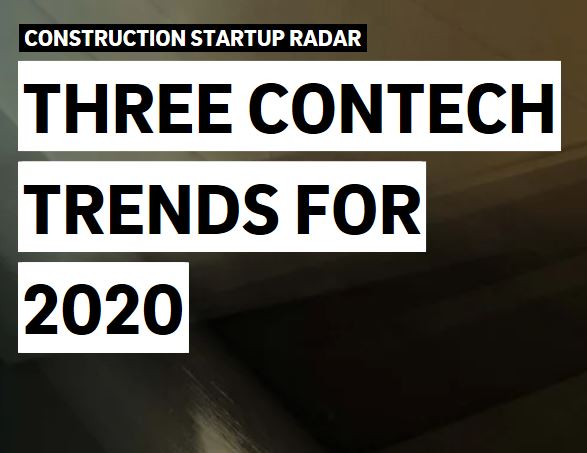In the past few years, new types of technology fields such as fintech, proptech, and insurance technology have emerged, but Contech, which means the combination of construction and technology, still comes as a term unfamiliar to us. While Proptech is a field that mainly deals with solutions used in building operation and maintenance related to real estate, Contech is related to the market in a form combined with technologies used in concept solutions, design, engineering, and construction. Proptech can be seen as a sub-field belonging to Contech.

Investment in contech companies is increasing rapidly worldwide. Consulting company Roland Burger interviewed about 20 contech startups to hear the prospect of the construction market in 2020 and the role of digitalization.
The start-up range included a variety of fields, from construction materials marketplace to project management software and AR./VR solutions. Through interviews, Roland Burger selected three trends in the contech field, which is a combination of architecture and technology.
The first is the use of AR/VR. AR/VR digitally turns the construction site into something of a type that is likely to be held in hand. A trade show booth using AR and VR technology for the construction industry is enough to attract people. AR Glas makes visitors become plumbers. Combined with a 3D model, it visualizes the pipes hiding behind the walls to show how to repair leaks. 3D or BIM models are easier to understand with VR glasses. Assuming that you have mastered how to use a VR controller or joystick, you can explore the model at the concept and design stage. In the virtual model, it is possible to annotate immediately when collisions between structures are identified. Using VR/AR has the advantage of allowing stakeholders of construction projects to check the structure in advance, regardless of location, before the building is completed.
The second is connectivity. A typical construction project involves numerous players in the construction process. 3M is important both on-site and off-site. 3M stands for Men, Machine, and Material, and this 3M must interact successfully for several years. Many start-ups predict that connecting these three through digitization will bring significant efficiency gains. It is expected that IoT, cloud computing, and wireless technologies can be combined to realize an integrated construction process. Sablono, a German construction management software company, explained that because project schedule management is becoming more and more complex, how to connect with stakeholders and properly link information and equipment during the construction process is an important factor.
The last is the future of field data and automation created by smart construction equipment. The construction industry is still one of the industries that relies heavily on pen and paper, especially in construction sites. Without digital data, in fact, it is difficult to see possible improvements, optimize processes, or expect efficiency. Systematic collection of field data is important because it is the basis for data analysis and big data artificial intelligence. It explains that collecting, analyzing and executing data in the construction industry will be an important factor for construction companies. For example, a sensor-equipped helmet collects information in the field and transmits it to project management software, enabling automatic data collection. In addition, as digital workflows can be built, data can be interpreted more meaningfully. Along with artificial intelligence technology, it is possible to increase productivity to predict budgets, schedules, and potential safety issues.
The use of technology has made it impossible for companies in the construction industry to sit back and claim that they are not ready for construction or not digitized. With the use of new technology and information, all companies participating in construction need to think about how to adapt to this new business model.


















Add comment